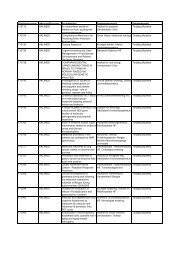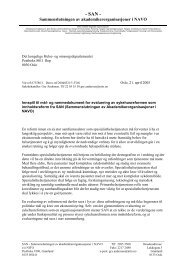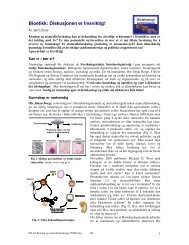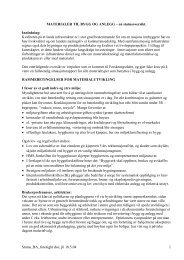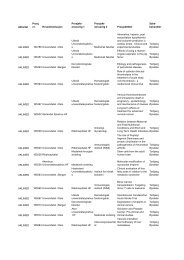A Revolution in R&D
A Revolution in R&D
A Revolution in R&D
Create successful ePaper yourself
Turn your PDF publications into a flip-book with our unique Google optimized e-Paper software.
isks <strong>in</strong>herent <strong>in</strong> genetics-based R&D, and explore<br />
various ways of manag<strong>in</strong>g them.<br />
Two K<strong>in</strong>ds of Genetics Approaches<br />
There are two relevant approaches to consider<br />
when assess<strong>in</strong>g the economic impact of genetics on<br />
DIAGNOSTICS—AN OPPORTUNITY TOO GOOD TO MISS…<br />
AND PERHAPS TOO GOOD TO GRASP<br />
It will be several years before genetics fulfills its<br />
promise. In the meantime, however, companies<br />
might beg<strong>in</strong> to enjoy a prelim<strong>in</strong>ary reward, <strong>in</strong> the<br />
form of diagnostics—essentially a byproduct of their<br />
broader genomics research programs. Certa<strong>in</strong>ly diagnostics<br />
is the subject of great expectations, though<br />
whether and how soon it will meet them rema<strong>in</strong>s to<br />
be seen.<br />
Many research projects <strong>in</strong> genomics and genetics<br />
will devise diagnostic tests as a matter of course—<strong>in</strong><br />
parallel with research or simply as a prelim<strong>in</strong>ary<br />
step, perhaps—without portray<strong>in</strong>g them that way.<br />
Diagnostic tests can be understood <strong>in</strong> a fairly broad<br />
sense here. Disease genetics, for example, <strong>in</strong> identify<strong>in</strong>g<br />
a target, is <strong>in</strong> effect f<strong>in</strong>d<strong>in</strong>g a marker of disease<br />
susceptibility. Expression profil<strong>in</strong>g, <strong>in</strong> identify<strong>in</strong>g the<br />
molecular differences characteriz<strong>in</strong>g a disease’s different<br />
subtypes, is po<strong>in</strong>t<strong>in</strong>g the way to differentiated<br />
and f<strong>in</strong>e-tuned therapies. And pharmacogenetics, <strong>in</strong><br />
identify<strong>in</strong>g variations <strong>in</strong> drug response among various<br />
patients, could be help<strong>in</strong>g to suggest the most<br />
suitable drug for them.<br />
The opportunities <strong>in</strong>herent <strong>in</strong> diagnostics will appeal<br />
to drug companies at several levels. First, costs are<br />
low. The <strong>in</strong>tellectual capital needed to develop a diagnostic<br />
test comes free, courtesy of exist<strong>in</strong>g research<br />
<strong>in</strong> drug discovery and development; validation<br />
studies can be run <strong>in</strong> parallel with drug efficacy studies,<br />
or perhaps can even simply borrow their results<br />
and extrapolate from them; and as for safety studies,<br />
diagnostic tests don’t need any. All <strong>in</strong> all, then, the<br />
<strong>in</strong>cremental spend<strong>in</strong>g required to develop a marketable<br />
diagnostic test is, relatively speak<strong>in</strong>g, paltry.<br />
R&D: disease genetics and pharmacogenetics. They<br />
operate at different stages of the value cha<strong>in</strong>.<br />
Disease genetics is <strong>in</strong>voked earlier, dur<strong>in</strong>g the discovery<br />
phase: it <strong>in</strong>volves the search for genes that make<br />
people susceptible to particular diseases, with the<br />
aim of then f<strong>in</strong>d<strong>in</strong>g targets. Pharmacogenetics is the<br />
Second, rewards are prompt. Diagnostics, <strong>in</strong> bypass<strong>in</strong>g<br />
most of the traditional steps of pharmaceutical<br />
R&D, can be brought to market not only far more<br />
cheaply than drugs, but far more quickly too. Drug<br />
companies are thereby able to realize some unusually<br />
fast payback on their R&D spend<strong>in</strong>g.<br />
Third, the market outlook is favorable. As new therapies<br />
proliferate, more diagnostics will be demanded;<br />
and as technologies advance, new types of diagnostics<br />
will become available. The signs are good.<br />
These opportunities are to some extent offset, however,<br />
if not by risks, then at least by challenges.<br />
There is the challenge of novelty, for <strong>in</strong>stance: for<br />
many traditional companies, diagnostics would<br />
<strong>in</strong>volve manufactur<strong>in</strong>g an unfamiliar k<strong>in</strong>d of product—<br />
a kit—and that <strong>in</strong> turn would <strong>in</strong>volve develop<strong>in</strong>g new<br />
capabilities, or else partner<strong>in</strong>g with a dedicated diagnostics<br />
company. Companies that have an <strong>in</strong>-house<br />
diagnostics division, such as Hoffmann-La Roche,<br />
Abbott, and Bayer, will have an advantage here.<br />
Then there is the challenge of <strong>in</strong>tellectual-property<br />
rights: companies might f<strong>in</strong>d it more difficult to<br />
assert those rights over diagnostics than over their<br />
f<strong>in</strong>d<strong>in</strong>gs <strong>in</strong> pharmaceutical research.<br />
Perhaps the most daunt<strong>in</strong>g challenge is tim<strong>in</strong>g: diagnostic<br />
tests will tend to emerge too speedily, becom<strong>in</strong>g<br />
available sooner than the therapies they <strong>in</strong>dicate.<br />
So the chief appeal of <strong>in</strong>vest<strong>in</strong>g <strong>in</strong> diagnostics—its<br />
prompt availability—may be undercut. Drug companies<br />
may have to delay market<strong>in</strong>g their diagnostics<br />
(and thus delay capitaliz<strong>in</strong>g on the opportunities)<br />
until their drug R&D pipel<strong>in</strong>es catch up.<br />
25



